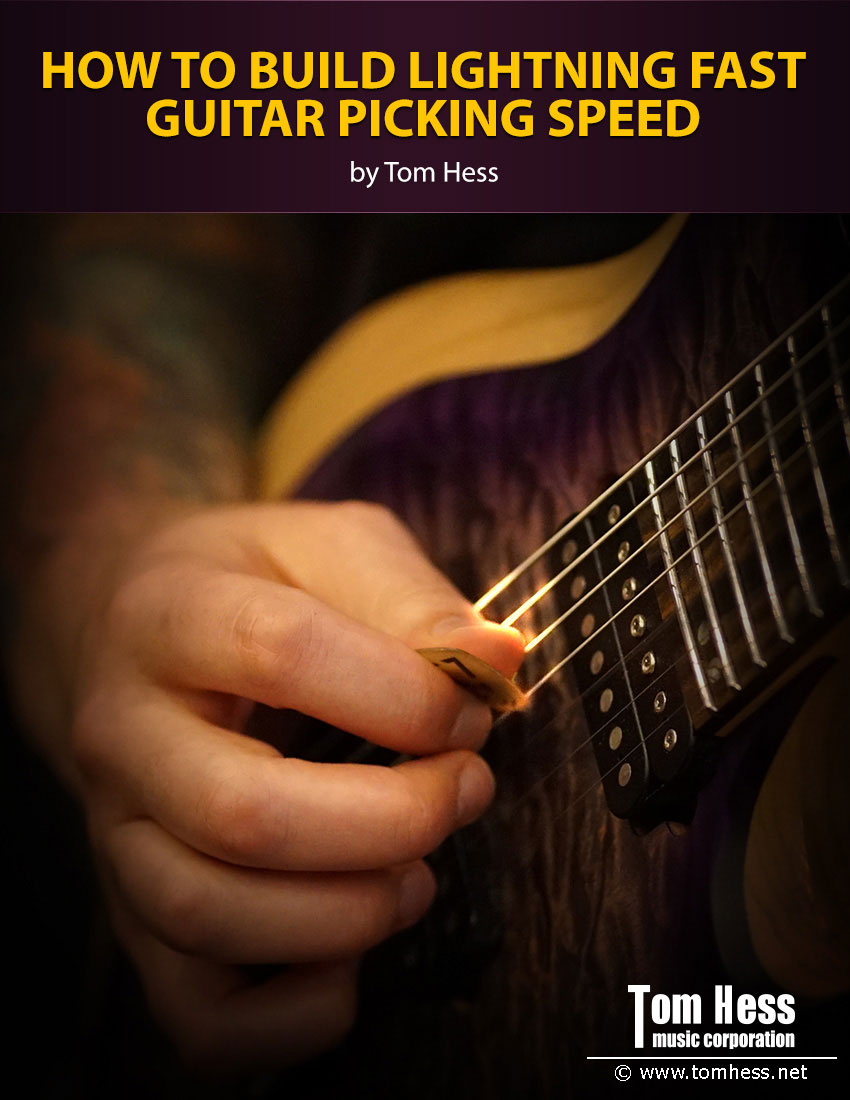Cool Phrygian Dominant Guitar Soloing Lead Guitar Tricks

EMAIL TO GET ACCESS
By submitting your info, you agree to send it to Tom Hess Music Corporation who will process and use it according to their privacy policy.
If you love the lead guitar licks of Yngwie...
Jason Becker...
And Joe Stump...
You’ll love the sound of the Phrygian dominant guitar soloing lead guitar ideas I’ll show you in this article.
You’ll learn:
- cool lead guitar phrasing ideas that light up your guitar licks and make everyone respect your playing
- simple ideas for adding more speed into your guitar solos
(these don’t take a lot of practice and make you sound pro, even if you’re not an advanced guitar player).
- new ways to approach guitar solos (that sound great in all keys and modes – even if you don’t use the Phrygian dominant mode in your music very often).

EMAIL TO GET ACCESS
By submitting your info, you agree to send it to Tom Hess Music Corporation who will process and use it according to their privacy policy.
Ready to have fun?
To begin...
Watch this lead guitar video to see the fun Phrygian dominant guitar lick ideas you can put into your next guitar solo:
Now that you know the basics of soloing using the Phrygian dominant scale, let’s go deeper.
Here are 5 more lead guitar soloing ideas to level-up your guitar playing:
Lead Guitar Playing Tip #1: Learn All 7 Positions Of The Phrygian Dominant Scale All Over The Guitar.
Here is a big tip for improving your lead guitar playing: when you learn any new scale – learn it all over your guitar in all of its positions.
That allows you to use the new scale in your lead guitar licks and solos smoothly and fluently.
What are the 7 positions of the Phrygian dominant scale?
They are the same as the 7 shapes of the harmonic minor scale. (The Phrygian dominant is the 5th mode of the harmonic minor scale).
Let’s take the E Phrygian dominant scale, for example. Its notes are: E F G# A B C D. From each of those 7 notes, you can build a scale pattern that spans all 6 strings.
Your task (that will greatly improve your lead guitar playing) is to memorize all 7 of those scale patterns.
How do you best learn all 7?
Here are some tips:
- challenge yourself to play in the shapes you don’t know as well. Sounds obvious, yes? Well, you’d be stunned at how often I see lead guitar players only play guitar licks in the scales shapes they know... and never go beyond them.
To learn the Phrygian dominant shapes faster, play guitar solos using the least familiar of the 7 scale positions. (Deliberately avoid the ones you already know well.
- Practice memorizing scale patterns away from the guitar. How? Simple: put your fretting hand on your picking hand’s forearm and mime the notes of whatever scale pattern you’re trying to memorize. This helps you learn the fingering much faster.
- Practice scale sequences instead of just playing scale patterns up and down. This makes practicing more fun and helps you create guitar licks with the scale shapes you’re learning.
Watch this video to see how simple and fun it is to sequence guitar licks:
- Practice playing scale patterns diagonally and horizontally (moving from the lowest fret on your fretboard to the highest fret on a single string or a pair of strings), instead of just up and down.
This is a fun way to create guitar lick ideas for lead guitar solos and it’s a good test of just how well you know the scale patterns.
Lead Guitar Playing Tip #2: Use Phrygian Dominant In Blues Lead Guitar Playing
“What”, you say? Use Phrygian Dominant for blues lead guitar playing?
Yep. Naturally, your guitar soloing won’t sound anything like blues when you do this… but it’ll still sound great and pro.
Here is what I mean:
When playing over chords A7 D7 and E7 (as an example), use these scales:
D harmonic minor (over the A7 chord)
G harmonic minor (over the D7 chord)
A harmonic minor (over the E7 chord)
Yes, you have to change scales (and keys) for each chord you play over (treating each chord as the V7 chord in a different key).
So, yes - this is a more advanced style of lead guitar playing than simply wailing on the same pentatonic box pattern over all 3 chords…
But this way of playing guitar solos makes you stand out and sound unique (in a good way) when jamming with your friends or even simply playing lead guitar over backing tracks.
Hint: in this guitar playing context, you want to use the most dramatic phrasing you can. If there
was ever a time to rip and play fast and intense guitar licks, this is it.
Watch this video to see why (and how to do it):
Question: “Tom Hess, but it feels blasphemous to use harmonic minor scales over a blues progression! It seems like it should be against the rules!”
Answer: Nothing in music is ‘against the rules’. There are only lead guitar playing approaches that are done more often or less often than others. And using the Phrygian dominant scale over a blues progression is definitely the latter.
That said, most guitarists (even hardcore blues lead guitar playing purists) often find this idea sounds awesome when they try it.
Believe it or not, I’ve even taught southern rock and blue guitarists to use (gasp!) sweep picking arpeggios in their blues solos (and they were loving the sound!).
Here is a video of one such guitar lesson:
Lead Guitar Playing Tip #3: Manipulate The Half Steps Of The Phrygian Dominant Scale In Your Guitar Solos
I find it amusing when lead guitar players say that the pentatonic scale is the most emotional scale of all time.
I think it’s nothing even close... because it lacks the most ingredient a scale must have to sound ‘emotional’:
The half step!
The half step (a distance of 1 fret on guitar) is by far the most emotional interval you can play in a lead guitar lick or guitar solo.
And alas, the traditional minor/major pentatonic scale is made up of whole steps and minor 3rd intervals. (No 2 notes are a half step apart.)
Meanwhile, the Phrygian Dominant scale contains not 1, not 2, but 3 half steps (between notes 1 and 2, 3 and 4, and 5 and 6).
This gives you lots of options for milking the emotional drama from the half steps in your guitar licks (especially during your string bends).
Watch this video to see how to create massive drama with string bends in your guitar playing (so you can use these ideas when manipulating the half steps in the Phrygian dominant scale):
Question: “Tom Hess, what other scales contain half steps that can be ‘milked’ for emotion and drama in guitar licks and solos?”
Answer: Lots of them, but 3 of my favorites include:
1. Mixolydian b6 (or the 5th mode of melodic minor). This scale is – in my opinion – the most dramatic and emotional guitar scale.
When you want to inject maximum emotion in your lead guitar playing, this is the scale you pull out.
2. Lydian (the 4th mode of the major scale). This scale has a beautiful floating-in-the-clouds type of feel and sound. You often hear the Lydian mode in the solos of Steve Vai and Joe Satriani.
3. The Hirajoshi scale (the minor scale with the 4th and 7th notes removed). This oriental pentatonic scale has an awesome sound and can easily be used over a variety of chord progressions.
Use any of these scales to make your lead guitar solos more emotional.

Lead Guitar Playing Tip #4: Make Your Lead Guitar Vibrato More Dramatic
Whether you solo using the Phrygian dominant scale or any other scale, vibrato is the key to making every part of your guitar solo sound awesome.
In a nutshell, vibrato is simply a rhythmic pulse applied to a note.
But how do you make your vibrato sound dramatic?
Here are the main elements to focus on:
- Balance the speed of your vibrato with its width. Here is what this means when it comes to vibrato: the wider the vibrato is, the faster it should be to sound good. The narrower it is, the slower it be.
If your vibrato is fast and narrow, it’ll sound nervous and out of control. And if your vibrato is slow and wide, it will sound like slow bends on top of a note vs. ‘vibrato’.
Watch this lead guitar playing video to see how to achieve a very controlled sound in your vibrato: - Control string noise: noisy vibrato sounds truly awful. But the good news is: controlling sloppy string noise is quite simple. Here is how to do it:
To mute string noise from the lower (thicker) strings, use thumb muting. Simply rest your picking hand’s thumb on the thicker strings (to keep them quiet). And slide the thumb up and down the strings as you play.
Watch this video to see how to do thumb muting for lead guitar: - Keep the vibrato in tune. This means 2 things: 1. bend the string up the same distance on each pulse of the vibrato, and 2. Release the string all the way back down to the neutral position. Both must be done to achieve an in-tune vibrato in your guitar licks.
Lead Guitar Playing Tip #5: Build Speed Using Speed Bursts
What does this have to do with guitar soloing using the Phrygian dominant scale?
Answer: phrygian dominant is the guitar scale often used for fast and intense lead guitar playing. As such, the more guitar speed you have, the more fun you can have with this awesome scale in your guitar playing.
(Plus, having more guitar speed makes everything you play feel easier, you make fewer mistakes and your playing feels more reliable and consistent, even on your worst days).
How do you build guitar speed using speed bursts?
Here are the steps:
Step 1: Choose a guitar lick you want to speed up.
Step 2: Set the metronome 10-15 bpm higher than your current top speed.
Step 3: Isolate a short (6-12 note) fragment from your guitar lick.
Step 4: Play your fragment at the faster speed ONCE… and stop.
After you stop, relax your body and ask yourself if all the notes in the fragment were totally clean or not.
Then, play the fragment again (just once) and pause for 3-5 seconds between repetitions. Clean up any notes that weren’t clean. Keep going until you are certain that the fragment sounds great and you are able to stay relaxed at the new (higher) tempo.
Then, add 2-4 more notes to it and repeat the process until you are playing the entire lick at the new (faster) guitar speed.
Watch this video to see an illustration of speed bursts in action:
Now that you know how to play better lead guitar solos using the Phrygian dominant scale, I want to help you build your guitar picking speed, so you can have an easier time playing the advanced guitar licks you want and impress everyone who hears you play. I show you how in my free eGuide: How To Build Lightning Fast Guitar Picking Speed. Download it today and discover the lead guitar speed building secrets most guitarists will never know.


Improve your guitar playing with the best online lessons for guitar.

